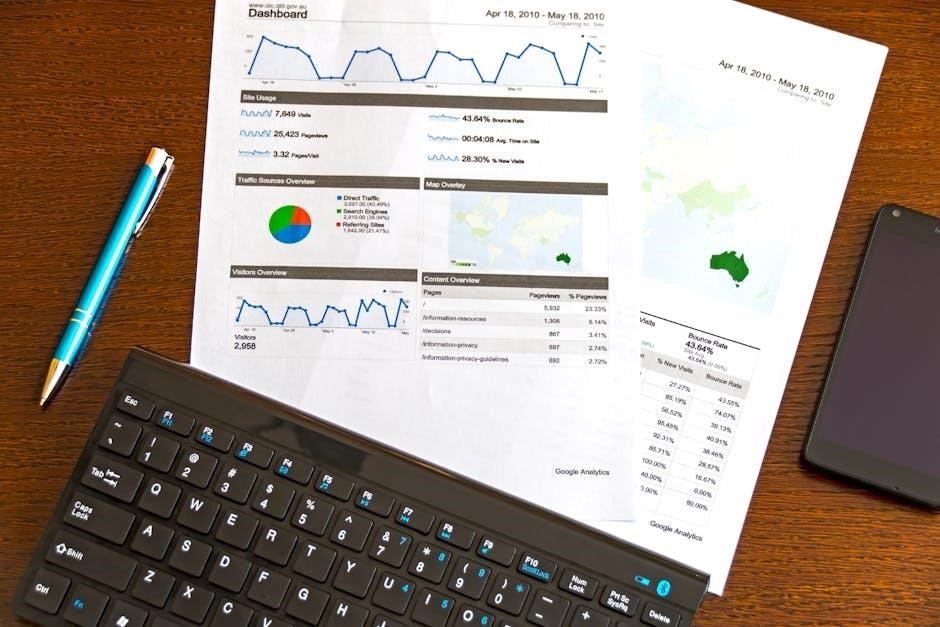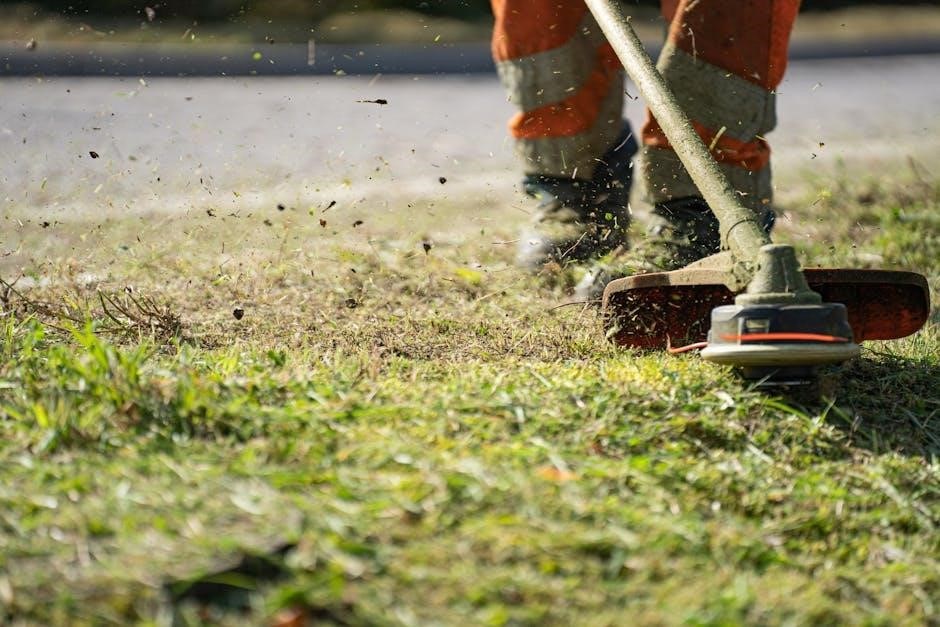
Reading poetry enriches the mind and connects us to diverse perspectives. This guide offers a structured approach to understanding and analyzing poems, helping you overcome challenges and unlock deeper meanings.
1.1 Importance of Reading Poetry
Reading poetry is essential for intellectual and emotional growth. It fosters empathy, creativity, and a deeper understanding of human experiences. Poetry challenges readers to think critically and explore complex emotions, making it a powerful tool for personal development. By engaging with poetry, individuals can gain insights into diverse cultures, historical contexts, and universal themes. It also enhances language skills and appreciation for literary devices. Poetry’s concise yet impactful nature encourages readers to slow down and reflect, promoting mindfulness and self-expression. Ultimately, reading poetry enriches our lives by connecting us to shared human experiences and broadening our perspectives on the world.
1.2 Common Challenges in Understanding Poetry
Understanding poetry can be challenging due to its unique structure, imagery, and symbolic language. Readers often struggle with unfamiliar vocabulary, complex metaphors, and abstract themes. The condensed nature of poetry requires careful attention to detail, which can be overwhelming. Additionally, the use of archaic language or experimental forms may confuse modern readers. Some poems lack a clear narrative, making it difficult to discern meaning. Emotional and intellectual demands of poetry can also intimidate readers, leading to frustration. However, these challenges are part of what makes poetry rewarding. Persistence and practice are key to unlocking its depths and appreciating its beauty.
Preparing to Read a Poem
Gather necessary tools like a dictionary and notebook. Read the poem multiple times, noting unfamiliar vocabulary, structure, and rhythm. Create a quiet, focused environment to enhance understanding.
2.1 Gathering Necessary Tools
To effectively analyze a poem, gather essential tools. Start with a dictionary to define unfamiliar words, enhancing comprehension. A notebook is crucial for jotting down observations, themes, and questions. Highlighters can emphasize key phrases or poetic devices, while a thesaurus helps explore alternative word meanings. Accessing literary guides or online resources provides deeper insights. A quiet, distraction-free space fosters focus. Having the poem printed or displayed clearly allows for easier annotation. These tools collectively create a structured environment, enabling a thorough and meaningful engagement with the poetry.
The First Reading
Begin by reading the poem silently to grasp its overall flow and emotion. Then, read it aloud to experience rhythm and tone, capturing first impressions without overanalysis.
3.1 Reading the Poem Silently
Reading a poem silently allows for an immersive, personal connection with the text. Begin by reading the poem from start to finish without interruption, letting the words and imagery sink in naturally. This approach helps you absorb the overall tone, themes, and emotional resonance without being distracted by technical aspects like rhythm. Pay attention to unfamiliar vocabulary and note any phrases or lines that stand out to you. Silent reading encourages a reflective and intuitive engagement, enabling you to identify your initial reactions and interpretations. It’s a crucial first step in developing a deeper understanding of the poem’s meaning and significance.
3.2 Reading the Poem Aloud
Reading a poem aloud enhances your connection to its rhythm, tone, and emotional depth. This method allows you to experience the natural flow of language and identify patterns like rhyme, meter, and enjambment. Pay attention to how certain words or phrases stand out when spoken, as this can reveal emphasis or hidden meanings. Reading aloud also helps clarify pronunciation and pacing, making complex structures more accessible. It’s a powerful way to engage with the poem’s musicality and uncover layers of meaning that may not be apparent during silent reading. This step bridges the gap between personal interpretation and the poet’s intended expression.

Understanding the Structure of a Poem
Poetry’s structure organizes ideas visually and rhythmically. Analyzing line breaks, stanzas, and spacing reveals how poets control pacing and emphasize themes, enhancing the reader’s interpretation and engagement with the text.
4.1 Analyzing Line Breaks and Stanzas
Line breaks and stanzas are essential elements of a poem’s structure. Line breaks determine the rhythm and pacing, influencing how the reader experiences the text. Stanzas group lines into meaningful segments, creating visual and thematic unity. Analyzing these elements reveals how poets emphasize certain words or ideas. For instance, a line break after a crucial word can create suspense or reflection. Similarly, the spacing between stanzas may signal a shift in tone or subject. By examining these structural choices, readers can uncover the poet’s deliberate arrangement of ideas and emotions, gaining deeper insight into the poem’s overall message and artistic intent.

Exploring the Language of Poetry
Poetry’s language is rich with imagery, symbols, and wordplay. Exploring these elements reveals deeper meanings and emotional resonance, helping readers connect with the poet’s unique voice and vision.
5.1 Checking for Unfamiliar Vocabulary
Encountering unfamiliar words is common when reading poetry. Start by identifying these terms and using context clues to infer meanings. If unclear, consult a dictionary or annotations to understand their significance. Some words may carry multiple meanings, so consider their connotations within the poem’s context. Unfamiliar vocabulary can sometimes obscure the poem’s message, but it can also enrich your understanding once deciphered. Pay attention to how these words contribute to the overall theme or imagery. If a word remains unclear, focus on the surrounding lines to grasp the poem’s essence. Effective analysis often requires patience and a willingness to explore language deeply.
5.2 Observing Imagery and Symbolism
Imagery and symbolism are essential elements in poetry, as they convey deeper meanings beyond literal interpretation. Imagery appeals to the senses, creating vivid mental pictures that enhance emotional resonance. Symbols, on the other hand, represent ideas, objects, or relationships beyond their literal meaning. To effectively observe these, pay attention to repetitive or evocative language. Ask yourself what the images or symbols might represent in the context of the poem’s theme. For example, a rose might symbolize love, while darkness could signify sorrow. These elements often layer the poem with complexity, inviting readers to explore multiple interpretations and connect with the poet’s intended message on a deeper level.

Analyzing Poetic Devices
Poetic devices are essential for conveying meaning. They include metaphors, similes, rhythm, and meter, which shape the tone, mood, and overall interpretation of a poem.
6.1 Recognizing Metaphors and Similes
Metaphors and similes are powerful tools in poetry, used to create vivid comparisons. A metaphor directly equates one thing to another, such as “time is a thief,” while a simile uses “like” or “as” to make a comparison, like “her smile shone like the sun.” Both devices enhance imagery and evoke emotions, helping readers connect deeply with the poem’s themes. Recognizing these elements requires close reading and attention to language. They often reveal the poet’s unique perspective and add layers of meaning to the text, making interpretation more engaging and insightful.
6.2 Understanding Rhythm and Meter
Rhythm and meter are essential elements in poetry, contributing to its musicality and emotional impact. Rhythm refers to the pattern of sounds, while meter is the measured beat created by stressed and unstressed syllables. Common meters include iambic (unstressed followed by stressed) and trochaic (stressed followed by unstressed). Paying attention to rhythm and meter helps readers feel the poem’s pulse and understand its tone. For example, iambic pentameter, commonly used in Shakespeare’s sonnets, creates a steady, rhythmic flow. Recognizing these patterns enhances your ability to interpret the poem’s mood and structure, making the reading experience more engaging and meaningful.

Identifying Themes and Tone
Identifying themes and tone reveals the poet’s message and emotional stance, guiding readers to interpret the poem’s deeper meaning effectively.
7.1 Determining the Central Theme
Determining the central theme involves identifying the main idea or message the poet conveys. This requires careful analysis of recurring imagery, symbols, and motifs. Readers should look for repeated patterns or ideas that emerge throughout the poem. Paying attention to the poet’s language and tone can also reveal underlying themes. It’s essential to consider the broader implications of these elements, as they often reflect universal concepts or personal reflections. By examining how these components interact, readers can uncover the poem’s core message, which may explore themes like love, nature, identity, or social issues. This step helps bridge the gap between literal meaning and deeper interpretation, enhancing understanding of the poet’s intent and the poem’s significance.
7.2 Assessing the Poem’s Tone and Mood
Assessing tone and mood involves understanding the emotional atmosphere and the poet’s attitude. Tone is conveyed through word choice, syntax, and language, revealing the poet’s feelings or perspective. Mood, on the other hand, is the emotional response evoked in the reader. To identify these, focus on descriptive language, imagery, and sensory details. For example, dark imagery may create a somber mood, while optimistic language can establish a hopeful tone. Pay attention to shifts in tone and mood throughout the poem, as they often signal changes in meaning or emotion. This analysis deepens your connection to the poem and enhances your interpretation of its overall impact.
Considering the Poet’s Background
Researching the poet’s biography and historical context provides insights into their influences and perspectives, enriching your understanding of the poem’s themes and intended message.
8.1 Researching the Poet’s Biography
Understanding a poet’s biography is crucial for deeper analysis. Their life experiences, cultural background, and historical context often influence their writing. Researching the poet’s biography can reveal themes, motifs, and personal struggles reflected in their work. For example, learning about their upbringing, education, or societal influences can provide insights into recurring themes in their poetry. Additionally, knowing their historical context helps explain references or allusions within the poem. Utilize literary guides, biographies, and credible online sources to gather this information. This step enriches your interpretation by connecting the poet’s life to their creative output, offering a more comprehensive understanding of their work.
8.2 Exploring the Poem’s Historical Context
Examining the historical context of a poem enhances understanding by revealing the societal, political, and cultural influences of its time. This involves researching the era in which the poem was written to identify relevant events, movements, or traditions. For instance, a poem from the Romantic era may emphasize nature and individualism, while a Modernist work might reflect post-war disillusionment. Understanding historical context helps decode allusions, slang, or references specific to that period. It also sheds light on the poet’s perspective on contemporary issues, making the poem more relatable and meaningful. This step bridges the gap between the past and present, enriching your interpretation of the poem’s themes and messages.
Interpreting the Poem’s Meaning
Uncover the hidden meanings and themes by connecting the poet’s message with personal experiences and emotions, allowing for diverse interpretations and deeper insights.
9.1 Making Personal Connections
Making personal connections while reading a poem enhances understanding and engagement. Reflect on how the poem resonates with your experiences, emotions, or beliefs. Identify imagery or phrases that evoke memories or feelings, allowing you to relate to the poet’s message on a deeper level. This connection fosters empathy and enriches your interpretation. By linking the poem to your life, you transform it into a shared experience, making it more meaningful. This personal engagement encourages active reading and helps uncover themes and emotions that might otherwise remain hidden. Your unique perspective adds layers to the poem’s interpretation, ensuring it becomes a personal and enriching journey.
9.2 Exploring Multiple Interpretations
Making personal connections with a poem involves engaging deeply with its content and relating it to your own experiences and emotions. Begin by reading the poem carefully, perhaps aloud, to fully grasp its rhythm and emotional nuances. Identify any unfamiliar vocabulary to ensure a basic understanding. Reflect on how specific lines resonate with you, considering moments in your life that mirror the poem’s themes or imagery. Empathy plays a crucial role; imagine the poet’s perspective and the emotions they convey, even if the subject is unfamiliar to you. Engage actively by underlining meaningful lines, journaling your thoughts, or discussing the poem with others to uncover new insights. This personal engagement transforms the poem into a shared experience, enriching your interpretation and making it deeply meaningful.
Practicing Poetry Analysis
Engage deeply by reading the poem multiple times, analyzing structure, language, and themes. Discuss interpretations with others to uncover new insights and refine your understanding.
10.1 Writing a Personal Response
Writing a personal response to a poem allows you to express your feelings, thoughts, and connections. Start by reflecting on what resonates with you, such as themes or imagery. Consider how the poet’s use of language and structure contributes to the overall meaning. Share your interpretations and reactions, even if they differ from others. This process helps deepen your understanding and fosters a more intimate relationship with the poem. Be honest and open, as personal responses are subjective and unique to your experience. Over time, this practice will enhance your analytical skills and appreciation for poetry.

Using Resources for Deeper Analysis
Utilize literary guides, online analysis tools, and comprehensive databases to enhance your understanding of poetry. These resources offer insights, historical context, and expert interpretations to deepen your analysis.
11.1 Consulting Literary Guides
Literary guides are invaluable for deepening your understanding of poetry. They provide detailed analyses, historical context, and expert insights, helping you interpret complex themes and poetic devices. These resources often include explanations of unfamiliar terms, discussions of the poet’s intent, and examples of critical interpretations. By consulting literary guides, you can gain a broader perspective on the poem’s meaning and significance. They are particularly useful for identifying patterns, motifs, and cultural references that might otherwise go unnoticed. Additionally, literary guides can offer diverse viewpoints, encouraging you to explore multiple interpretations and enrich your analytical skills. They serve as a bridge between the poem and the reader, fostering a more informed and engaging reading experience.
11.2 Utilizing Online Analysis Tools
Online analysis tools offer a wealth of resources to enhance your understanding of poetry. Websites like Poetry Foundation and RhymeZone provide detailed analyses, word definitions, and explanations of poetic devices. These tools often include features such as keyword searches, rhyme scheme generators, and audio recordings of poems being read aloud. Additionally, platforms like SparkNotes and LitCharts offer in-depth summaries and critical essays, helping you grasp complex themes and motifs. Online tools also allow you to explore multiple interpretations and compare analyses, fostering a deeper engagement with the text. They are accessible, user-friendly, and cater to both beginners and advanced readers, making poetry analysis more efficient and enjoyable.
12.1 Summarizing Key Takeaways
To effectively read and analyze poetry, start by understanding the poem’s structure, themes, and language. Pay attention to line breaks, stanzas, and poetic devices like metaphors and rhythm. Reading aloud enhances comprehension and connects you to the poem’s musicality. Identify unfamiliar vocabulary and explore imagery and symbolism to uncover deeper meanings. Consider the poet’s background and historical context for added insights. Reflect on the tone and mood to grasp the emotional essence; Finally, make personal connections and explore multiple interpretations to enrich your understanding. By applying these strategies, you’ll become a confident and insightful poetry reader, ready to uncover the richness of poetic expression.
12.2 Encouraging Continued Exploration
Reading poetry is a lifelong journey that offers endless discovery. Encourage yourself to revisit poems, as new insights often emerge with each reading. Explore diverse poets and styles to broaden your understanding. Utilize online resources, literary guides, and analysis tools to deepen your engagement. Join discussions or workshops to share perspectives and learn from others. Keep a journal to record your thoughts and reflections, tracking your growth as a reader. Most importantly, embrace poetry as a personal journey, allowing it to inspire and enrich your life. By fostering curiosity and persistence, you’ll continue to uncover the beauty and meaning of poetry.


























































